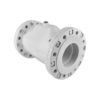Wine Manufacturing with the aid of Valves
An award-winning wine manufacturer based in the UK are using flanged Pinch Valves from AKO UK’s VF range on their grape press machines. A control panel operates the valve. The company makes wine from fresh grapes, which are crushed and pumped into the press via the axial feed shown in the pictures below.





